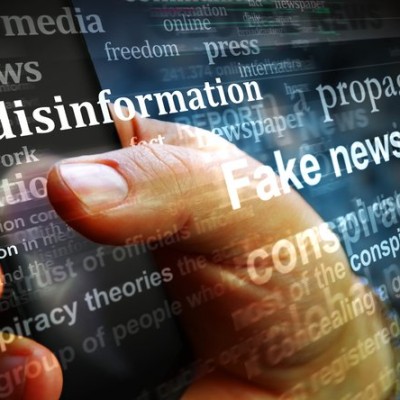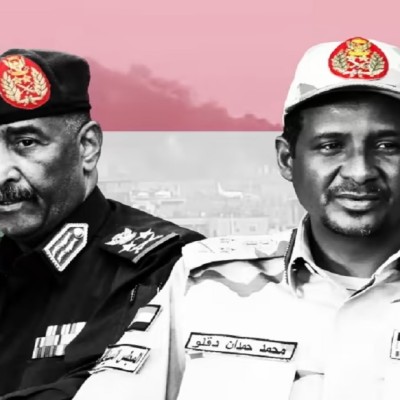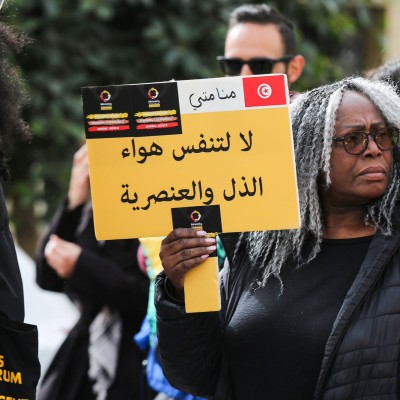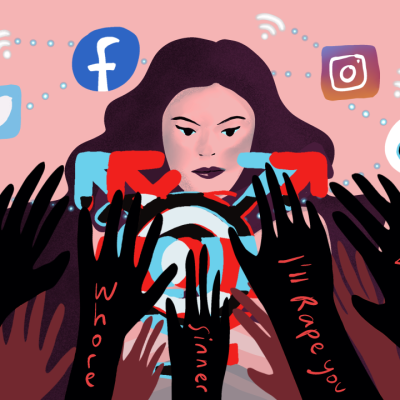Behind the Smoke: How Does Disinformation Surrounding Syria's Chemical Attacks Undermine Public Health?
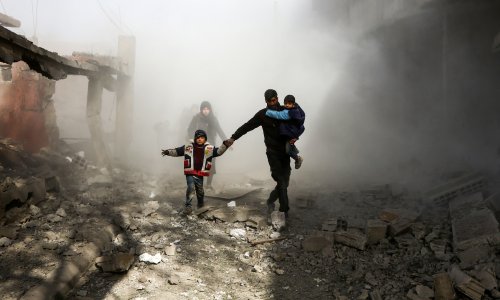
Salma Daoudi
This month marks the commemoration of two of the Syrian regime’s chemical attacks on the Syrian population: the seventh anniversary of the attack on Khan Sheikhoun city and the sixth anniversary of the attack on Douma city.
Tragedies in their own right, these two events have also been conceited by a cloud of disinformation that unveils how the Assad regime weaponizes misinformation to maintain opacity surrounding its war crimes, ensure its survival, and evade accountability.
While the immediate impact of the attacks resulted in the indiscriminate killing and injury of its victims, the accompanying disinformation and denialism campaigns hindered urgent medical and humanitarian interventions, undermined public trust in the health sector, and hampered the latter’s ability to navigate misinformation and respond to health crises.
This article seeks to further explain the ramifications of the strategic use of disinformation to manipulate public perceptions related to engineered public health crise, touching upon the difficulties health workers and organizations face amidst information scarcity, the erosion of trust in health information, and the exploitation of health narratives for political ends.
A series of chemical weapons attacks by the Assad regime
The use of chemical weapons in Syria has been documented and confirmed by several human rights organizations, including Human Rights Watch, based on physical evidence, testimonies, and medical accounts. According to a study published by the Global Public Policy Institute, over 336 chemical attacks have been carried out in the country between 2012 and 2019, over 98% of which are attributable to the Syrian government. Casualties included at least 1900 direct deaths and over 18700 injuries.
The majority of these deaths occurred following one of the first and largest chemical attacks conducted by the regime on the Eastern and Western Ghouta suburbs of Damascus. Previous instances of smaller-scale attacks were reported by Syrian opposition activists, but the Ghouta chemical attacks of 2013 represent a watershed moment in the chemical weapons usage.
Not only did they mark one of the deadliest chemical assaults in recent history, but they also tested the international community’s resolve, which failed to hold the regime accountable. The Syrian regime faced no consequence after it targeted on August 21st, 2013 twodensely populated districts with sarin, a nerve agent that led to the suffocation, convulsion, and agonizing death of the local population.
Evidence overwhelmingly pointed to the Syrian regime as the perpetrator, but the regime never claimed responsibility, blaming instead rebel forces. Through Russian mediation, the U.S. negotiated an agreement to dismantle Syria's chemical weapons, but despite Syria eventually signing on the Chemical Weapons Convention (CWC), reporting to have destroyed all critical equipment and chemical weapons facilities, and collaborating with an OPCW-UN mission to verify compliance, chemical attacks continued at alarming rates.
In a disturbing déjà vu, the Khan Sheikhoun chemical attack of 2017 echoed the horrors of the Ghouta assaults. The nerve agent, believed to be sarin or a similar substance, released in the town of Khan Sheikhoun in the Idlib province claimed the lives of over 70 civilians, including children, and left in its trail scores of injured and traumatized victims.
The large-scale act of violence reignited global debates on accountability, the enforcement of international norms, and the urgency of addressing the rampant use of chemical weapons in the Syrian war. As the international community grappled with the shock of such a blatant violation of international norms, the Syrian regime engaged yet again in a concerted effort to deny its involvement. This denialism was not merely a tactic to deflect blame. Rather, it became a strategic tool to manipulate narratives, hinder humanitarian efforts, and serve set political and military ends.
These attacks were not only marked by the immediate devastation they wrought but also by the subsequent strategic manipulation of information to shape narratives, undermine the public health response, and achieve set political objectives. Denialism surrounding the use of chemical weapons by the Syrian regime has not only hindered immediate humanitarian efforts and diplomatic responses, but also exacerbated the health challenges faced by Syrians over the long-term. The spread of contradictory narratives, coupled with a lack of accurate health information, presented healthcare providers with the daunting task of navigating health crises amidst confusion and with limited resources.
Moreover, the erosion of trust in health information further complicates the prevention and containment of current disease outbreaks, as public skepticism has interfered with healthcare seeking behaviors and adherence to medical guidelines. Given the lack of fully functional health infrastructure and of medical staff, the reluctance to seek adequate care facilitated, and continues to facilitate, the rapid spread of diseases at rates exceeding local capacities.
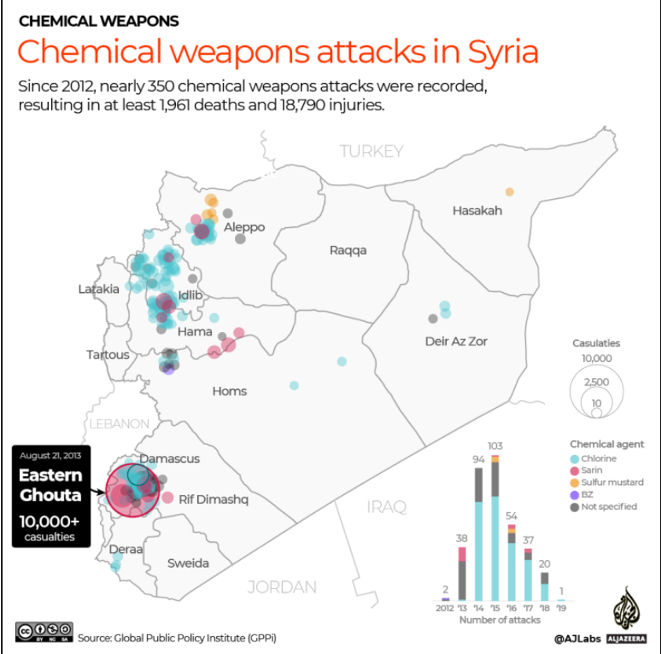
Informational warfare: At the crossroad of battlefields
The Syrian regime’s informational warfare relied predominantly on causing enough confusion to cast doubt on the plausibility of the attacks and its own possible involvement. This coordinated dissemination of disinformation through traditional media was coupled with viral campaigns on various social media platforms to amplify the narrative and sow seeds of doubt, but this article focuses specifically on the arguments propagated by outlets close to the Syrian apparatus or its allies.
Indeed, Syrian allies used conventional media to present the allegations as a politically motivated and rebel-orchestrated campaign to justify airstrikes conducted against Syria. Outlets such as Al Masdar New, RT, Sputnik, and Mehr News were instrumental in advancing the Syrian regime’s main talking points.
Al Masdar News, for example, published an article shortly after the Khan Sheikhoun attacks, arguing that severe inconsistencies undermined claims that a nerve agent was used against the population of Idlib. The article referred specifically to footage circulated by first responders in order to cast doubt upon the nature of the injuries treated, asserting that it does not match exposure to sarin gas.
More importantly, and consistent with the line of argument advanced by other Syrian and Russian-controlled outlets, the article accused the White Helmets, a civil defence group involved in rescue efforts, of collaborating with foreign powers and rebel groups to frame the Syrian regime.
The lack of use of protective gears by White Helmets first responders was, for instance, attributed to a poorly designed and staged scene, rather than a natural consequence of the blockade preventing vital humanitarian aid from reaching Idlib.
The Syrian Arab News Agency echoed these attempts to discredit the organization and accused the White Helmets of deliberately killing children to “use them in staged videos about alleged chemical attacks, whether in Khan Sheikhoun or in other Syrian areas”. Delegitimizing an already underfunded task force served to further hamper the White Helmets’ ability to provide appropriate and necessary care following attacks on civilians, whether chemical or otherwise.
The White Helmets were further accused of “conspiring with Western nations to carry out strikes against the Syrian military and its allies” and of planning to train Ukrainians on how to fabricate a false-flag attack.
Indeed, not only does RT dedicate several articles to defending the Syrian government from chemical use allegations, it also utilizes the story as an emblematic example of false-flag operations orchestrated by powers hostile to Russia.
An article focused exclusively on Syria mentions explicitly that “the US government used the allegations as justification to launch air strikes against the Syrian government,” whereas another article discussing the conflict in Ukraine starts with a reminder of the illegitimacy and inaccuracy of the evidence presented against Syria, to accuse the US of preparing a similar scenario to frame Russia in Ukraine.
Articles published on Sputnik invoked testimonies collected by the Russian Reconciliation Center from doctors and state organizations to assert that no patients displayed signs of chemical poisoning following the 2018 Douma attacks, contradicting statements from doctors involved in treating the victims.
According to the director of the Union of Medical Care and Relief Organisations (UOSSM), the Syrian regime pressured members of the medical corps to publicly deny the occurrence of the gas attack in Douma through violent intimidation campaigns and coercion, even while health facilities were overwhelmed with a severe inflow of suffocating and burned victims.
Humanitarian paralysis: How denialism hampers urgent medical interventions
The regime’s alleged public adherence to the CWC helped obfuscate its role in the attacks, as well as hinder humanitarian and medical relief efforts. The lack of transparency surrounding the attacks and the chemical agents used deprived medical teams on the ground from the ability to immediately diagnose symptoms of contamination and provide adequate care in a timely manner.
Testimonies from medical personnel on duty during the Ghouta attacks point out to utter confusion in the face of the large influx of suffocating patients that overwhelmed local health facilities, many of whom were foaming at the mouth, choking, convulsing, and suffering from impaired vision. This engineered environment of information chaos hindered the accurate identification and treatment of chemical exposure symptoms.
Médecins Sans Frontières reports at least 3,600 persons were treated for symptoms consistent with exposure to neurotoxic agents at the hospitals it supports in the area. Healthcare providers faced challenges in administering appropriate care due to a lack of acknowledgment of the specific agents used in the attacks. Not only did health personnel lack access to reliable information to diagnose and treat incoming cases, but they also lacked the necessary resources.
The areas affected by the Ghouta attacks already suffered from undersupplied health facilities, many of which were no more than makeshift underground clinics established to provide medical assistance. The establishment of secret underground facilities resulted from both a security imperative due to the heavy bombing of hospitals or their infiltration by security forces, as well as a logistical imperative to evade the tight sieges preventing the entry of medical supplies and equipment.
Additionally, in the days leading up to the Ghouta attacks, several health facilities were targeted with conventional munitions, significantly undermining the capacity of an already weak and under-resourced health infrastructure to mitigate the public health catastrophe in the aftermath of the attacks.
The majority of the healthcare personnel who attended to the incident suffered severe health consequences and many were reported dead, further incapacitating the healthcare force. Similarly, during the 2017 sarin attacks, airstrikes targeted the very same hospitals where the attacks’ victims were being transferred for treatment. About 10 airstrikes targeted the main medical facility and the civil defence centre, putting both out of service. The physical damages inflicted upon the facilities as well human losses incurred constrained the ability to promptly mitigate the consequences of the chemical attacks.
As such, denialism added to the deliberate incapacitation of the health system impeded swift international humanitarian responses, delaying the delivery of critical medical assistance and aid to the affected populations.
The Syrian government's refusal to acknowledge its role created bureaucratic hurdles, restricting access for humanitarian organizations and hindering the timely deployment of medical teams to the affected areas. Many agencies have also been forced to cease operations or have seen funds reduced or cut as a result of the disinformation campaigns targeting organizations that provide medical aid to areas falling outside regime control. While some hospitals still managed to purchase new supplies of antidotes to treat nerve agents following the Ghouta attacks, the Syrian regime’s declaration that it had had agreed to give up its chemical arsenal through the American-Russian mediated agreement gave local health authorities a false sense of safety.
Consequently, the medication expired and was not re-stocked, causing significant healthcare access gaps during subsequent chemical attacks. Starting 2017, the WHO has worked on distributing medical kits for the treatment of chemical exposures in besieged areas of rural Damascus and in northern Syria; however, not only do some chemical agents such as chlorine or blister lack antidotes, but many areas across Syria have also remained unreachable to intergovernmental organizations.
By casting doubt on the veracity of evidence and deflecting blame, the Syrian regime has obstructed emergency medical assistance and international intervention. However, the enduring health challenges faced by Syrians extend far beyond the initial impact of chemical attacks. Exposure to toxic agents can result in lingering health effects manifesting as chronic respiratory conditions, neurological disorders, and other persistent conditions. Previous evidence from the health consequences of the 1988 Halabja massacre points to the increasing incidence of birth defects, congenital defects, and cancers.
Further research is needed to assess the exact long-term impacts of exposure to chemical weapons in the Syrian context, but the Syria Justice and Accountability Centre reports physicists’ concern about the significant rise in the number of children born with birth defects since 2015.
Yet, the reluctance to acknowledge the full extent of the health crisis by health authorities hampers the conduct of further comprehensive studies and perpetuates a cycle of suffering, impeding the restoration of normalcy for affected populations. As a matter of fact, denialism not only obstructs accurate diagnosis and treatment, but also contributes to the exacerbation of chronic conditions, as the lack of official acknowledgment hinders the development of targeted healthcare strategies.
It also inflicts a unique form of psychological warfare on survivors, not only by discrediting the trauma resulting from chemical exposure and the loss of loved ones, but also deepening the sense of distrust and betrayal resulting from the lack of accountability and justice. Rising rates of anxiety, depression, and post-traumatic stress disorder are usually reported among populations affected by chemical warfare events, as they suffer from lingering and acute psychological distress.
Chemical weapons are, after all, weapons of terror, designed to induce lingering panic, confusion, and uncertainty. Coupled with deliberate and strategic disinformation, their volatile use by the Syrian regime entertains constant anxiety and fear of experiencing once more the agony of suffocation. Unlike that of chemicals, the smoke of fear and confusion never truly dissipates.
The fog of confusion: Public health under threat
The resulting constant state of confusion entrenched several challenges healthcare providers were contending with. within an environment fraught with disinformation and information scarcity. The fragmentation of the Syrian public health system, precipitated by the regime’s deliberate targeting of health facilities and besiegement of cities, has severely hampered the flow of information exchange and the maintenance of operational monitoring systems. This impaired communication contributes to the spread of misinformation, making it challenging to implement effective public health strategies and perpetuating the long-term health consequences of denialism.
The conflicting narratives produced by different actors surrounding major public health crises, ranging from the regular chemical attacks overwhelming local health facilities to major outbreaks paralyzing the entire system at large, make it difficult for providers to navigate and respond effectively.
Firstly, the weaponization of health information creates an environment where facts are elusive, and misinformation becomes a strategic tool. For healthcare providers, this means navigating a landscape where the very information crucial to their work is distorted, manipulated, and weaponized for political ends. From the identification of chemical agents used to the implementation of safety protocols, providers must navigate a landscape of uncertainty where the veracity of information directly impacts the effectiveness of their response. Inconsistent information about the nature of the outbreak, preventive measures, and treatment protocols undermines providers' ability to mount an effective response.
The paralysis of the healthcare system during major outbreaks is vividly demonstrated by the Syrian government's response to the COVID-19 pandemic. Conflicting narratives regarding the prevalence of the virus and the effectiveness of preventive measures, coupled with the lack of transparent communication, hindered the implementation of a coordinated response. The regime initially refused to acknowledge the pandemic had reached its borders and silenced dissident voices, even while northern Syria was experiencing a severe wave outpacing undersupplied health facilities. The healthcare system's ability to effectively manage the pandemic was compromised, exacerbating its impact on the population.
Secondly, organized online disinformation campaigns supported by pro-Russian and pro-government media have specifically targeted frontline rescue workers and doctors, amidst other human rights defenders denouncing the regime’s crimes.
The primary disinformation strategy employed by the Syrian regime involved portraying these individual as either terrorists or foreign operatives, sowing further distrust and fear amongst the population. As discussed above, the Syrian Civil Defence, also known as the White Helmets, were repeatedly falsely accused by state-controlled media accounts to have themselves used chemical weapons in Idlib, Hama, and Aleppo, even though no institution confirmed their implication in any capacity other than being rescuers and first responders.
Both Russia and Syria are known for providing unreliable information to distract from the Assad regime’s use of chemical weapons, resorting to conspiracy theories and the manipulation of satellite imagery or fake material.
These accusations nevertheless contributed to the erosion of public trust in healthcare systems, in addition to fear of association, hindering the implementation of crucial public health measures and vaccination campaigns. As affected communities, by diseases or chemical attacks, struggled to reconcile their experiences with the official state-promoted narrative, their willingness to seek timely medical assistance was hindered. This carries significant implications for health-seeking behaviours, vaccination rates, and adherence to public health guidelines.
Accountability as a public health emergency
The exploitation of distorted health narratives for political ends undoubtedly fractures the bond between healthcare providers and the communities they serve. In the specific context of Syria, the manipulation of these narratives has reflected the prioritization of political objectives over public welfare.
Under international humanitarian law, the Syrian regime has an obligation to refrain from attacking medical facilities and personnel as per Security Council Resolution 2286 (2016) and to refrain from the use of chemical weapons. By not only breaching these but also spreading misinformation aimed at undermining public health response to the public health crises it is contributing to, the Syrian regime has effectively intensified the impact of its attacks on public health. Yet, holding war crime perpetrators accountable in the context of strategic disinformation is challenging.
The lack of a transparent and truthful narrative obstructs international efforts to pursue justice for the victims, reinforcing a culture of impunity that perpetuates the cycle of human rights abuses. Concerns surrounding the continued use of chemical weapons in Syria are salient, especially given the lack of concrete legal and political consequences.
With access to the field being severely restricted and survivors’ testimonies purposefully discredited by pro-government forces, legal pathways to justice seem obstructed. However, the leading efforts of Syrian legal experts, activists, and rights groups are laying the groundwork for an initiative aiming to establish a treaty-based tribunal putting on trial actors reported to have used chemical weapons to harm civilian populations. This would constitute an essential step towards not only closing the impunity gap and deterring future use, but also lifting the veil on the real scale and extent of the harmful health consequences caused by these attacks.
